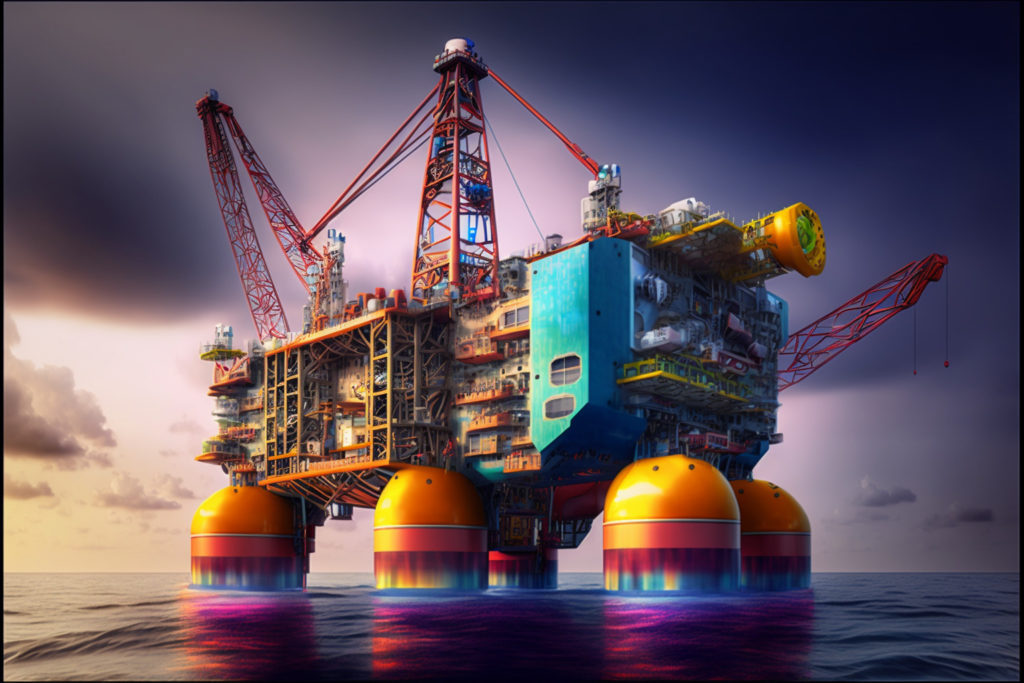I. Introduction
Offshore Installation, Construction, Development, and Operations
Offshore installation, construction, development, and operations refers to the various activities involved in the creation and maintenance of offshore energy infrastructure, including oil and gas platforms, wind farms, and other energy sources. These activities play a critical role in meeting the world’s energy demands, as they allow energy companies to tap into previously inaccessible offshore energy reserves.
Importance of the Industry in the World’s Energy Supply
According to the International Energy Agency (IEA), the global demand for energy is expected to rise by approximately 30% by 2040. Offshore energy production will play a crucial role in meeting this demand, as offshore oil and gas reserves are estimated to account for nearly 60% of the world’s total oil and gas production by 2040. The offshore wind energy market is also expected to grow rapidly, with investments in this sector estimated to reach $200 billion by 2030.
The Need for Market Research in the Industry
In order to capitalize on the growth opportunities in the offshore installation, construction, development, and operations industry, it is crucial for companies to understand the current market trends, technology advancements, and regulatory environment. This requires in-depth market research, which can help companies make informed business decisions and stay ahead of the competition.
To learn more about the current state of the offshore installation, construction, development, and operations industry and what the future holds, be sure to check out our other reports by clicking here.
II. The State of the Offshore Industry
The offshore installation, construction, development, and operations industry is undergoing rapid growth and evolution. Companies in this industry are utilizing cutting-edge technologies and innovative practices to unlock the potential of offshore energy resources and meet the growing demand for energy around the world.

A. Current market trends in offshore installation, construction, development, and operations
In recent years, there has been a significant increase in investment in offshore wind projects. According to a report by the Global Wind Energy Council, the global offshore wind capacity reached 40.9 GW in 2020, representing a growth of 26% from the previous year. This growth is largely driven by the declining cost of wind energy and the increasing focus on renewable energy sources.
In addition to offshore wind, there is also growth in offshore oil and gas production. According to a report by the International Energy Agency, the global offshore oil and gas production reached 28 million barrels of oil equivalent per day in 2020, an increase of 2% from the previous year. Companies such as BP and Shell are investing heavily in offshore oil and gas exploration and production to meet the growing demand for energy.
B. The role of technology in the industry’s growth
Technology is playing a crucial role in the growth of the offshore installation, construction, development, and operations industry. Companies are using advanced technologies such as drones, robots, and autonomous systems to improve the efficiency and safety of offshore operations. For example, the use of drones for inspections and surveys has reduced the need for costly and time-consuming manual inspections, while the use of robots has improved the efficiency of underwater operations.
In addition to improving efficiency, technology is also helping companies to reduce their environmental impact. For example, offshore wind farms are using advanced wind turbine technologies to increase energy output and reduce the visual impact of wind farms. Meanwhile, offshore oil and gas companies are using enhanced oil recovery techniques to extract more oil and gas from existing wells while minimizing their environmental impact.
C. Challenges faced by companies in the industry
Despite the growth and potential of the offshore installation, construction, development, and operations industry, companies in this industry face a number of challenges. One of the biggest challenges is the high cost of offshore operations, which can make it difficult for companies to compete with onshore energy sources. Another challenge is the difficulty of operating in harsh offshore environments, which can pose significant risks to personnel and equipment.
In addition, companies in the industry must also comply with a range of government regulations, including environmental and safety regulations. These regulations can add to the already high cost of offshore operations and can slow down the development of new projects. Despite these challenges, companies in the offshore installation, construction, development, and operations industry are continuing to invest in technology and innovation to overcome these challenges and unlock the full potential of offshore energy resources.
III. Unlocking the Potential of Offshore Installation, Construction, Development, and Operations
Offshore installation, construction, development, and operations are critical components of the energy industry. As the demand for energy continues to grow, the industry must find ways to increase efficiency and reduce costs. In this section, we will explore best practices, the impact of government regulations, and the role of innovation and sustainability in the industry.
A. Best Practices in the Industry
To unlock the full potential of the offshore industry, companies must adopt best practices. One of the most important is risk management. Companies must be able to identify and mitigate risks associated with offshore operations, including natural disasters, equipment failure, and human error. By proactively addressing these risks, companies can minimize downtime and protect their investments.
Another best practice is collaboration. Offshore installations often involve multiple companies and contractors, each with their own areas of expertise. By working together and sharing knowledge and resources, companies can reduce costs and improve safety. For example, the The International Renewable Energy Agency (IRENA) is a network of governmental organisations that collaborate on research and development projects to advance the industry.
B. The Impact of Government Regulations
Government regulations play a significant role in the offshore industry. Regulations help to ensure safety and environmental protection, but they can also increase costs and slow progress. For example, the Bureau of Safety and Environmental Enforcement oversees offshore drilling in the United States and imposes strict safety and environmental standards. While these regulations are necessary, they can also create obstacles for companies looking to enter the market.
To balance the need for safety and environmental protection with the need for growth, governments must find ways to streamline regulations and make them more flexible. For example, the European Union has established a set of common standards for offshore wind farms, allowing companies to operate more efficiently across borders. By finding a balance between regulation and innovation, governments can support the growth of the offshore industry while protecting the environment and public safety.
C. The Role of Innovation and Sustainability
Innovation and sustainability are critical drivers of growth in the offshore industry. Companies are constantly looking for ways to increase efficiency and reduce costs, and sustainability is becoming an increasingly important factor. For example, the development of floating wind turbines has made it possible to generate energy from offshore wind in deeper waters, expanding the potential of the industry.
Sustainability is also a major concern for governments and consumers, and companies must find ways to reduce their carbon footprint and operate in an environmentally responsible manner. For example, the Shell WindEnergy division is exploring the use of hydrogen fuel cells to power offshore installations.
IV. Market Analysis and Forecast
A. Market Size and Growth Rate of the Offshore Installation Industry
The offshore installation, construction, development, and operations industry has seen significant growth in recent years. According to a report by Grand View Research, the global offshore installation market size was valued at $47.3 billion in 2020 and is expected to grow at a CAGR of 6.7% from 2021 to 2028. The increasing demand for energy, coupled with advancements in technology, has driven the growth of the industry.
In order to determine the best locations for oil extraction, geologists conduct surveys using both ships and satellite imagery. Once the optimal spot is identified, a rig is towed to its location and installed, with the intent of long-term operation in a single spot. The process of offshore installation requires extensive planning and investment, making it a significant component of the offshore industry.
Despite the high costs and risks associated with offshore installations, the potential rewards make it a lucrative industry. With the rise of oil prices, companies have been increasing their production, leading to a corresponding increase in demand for offshore installations. As such, we predict that the offshore installation industry will continue to grow and evolve in the coming years, becoming an increasingly important player in the global petroleum industry.
B. Key Players in the Industry
The offshore installation, construction, development, and operations industry is dominated by a few key players. Major companies in the industry include Saipem, Subsea 7, Van Oord, Aker Solutions, and TechnipFMC. These companies have extensive experience and expertise in the industry, and their investments in technology and innovation have helped them maintain their position as leaders in the market.
C. Future Market Trends and Growth Opportunities
The future of the offshore installation, construction, development, and operations industry looks promising. The increasing demand for energy and the need for sustainable solutions are driving growth in the industry. In addition, advancements in technology are expected to further drive growth in the industry. For example, the use of autonomous vessels and drones in the industry is expected to become more widespread in the coming years, leading to increased efficiency and reduced costs.
Additionally, the growing demand for renewable energy sources such as wind and solar energy is expected to drive growth in the offshore installation, construction, development, and operations industry. For instance, the global offshore wind energy market is expected to reach $130 billion by 2030, according to a report by Research and Markets.
Furthermore, the growth of emerging economies such as China and India is expected to increase the demand for energy, leading to increased investment in the offshore installation, construction, development, and operations industry.
In conclusion, the offshore installation, construction, development, and operations industry is expected to continue its growth trajectory in the coming years, driven by increasing demand for energy, advancements in technology, and the need for sustainable solutions.
V. Conclusion
In conclusion, the offshore installation, construction, development, and operations industry is a critical component of the world’s energy supply. The industry has seen significant growth in recent years and is expected to continue to expand in the future. Key trends in the industry include the use of technology, innovation, and sustainability, as well as the impact of government regulations. Market research is crucial for companies in the industry to stay ahead of the curve and take advantage of growth opportunities.
To summarize, the offshore industry is currently experiencing rapid growth and is expected to continue to grow in the future. Companies in the industry are taking advantage of technological advancements, sustainable practices, and favorable government regulations to unlock the full potential of the industry. Market research is essential for companies looking to stay ahead of the curve and take advantage of growth opportunities.
Key Takeaways:
- The offshore installation, construction, development, and operations industry is a crucial component of the world’s energy supply.
- The industry is experiencing rapid growth and is expected to continue to grow in the future.
- Key trends in the industry include the use of technology, innovation, and sustainability, as well as the impact of government regulations.
- Market research is essential for companies looking to stay ahead of the curve and take advantage of growth opportunities.
The importance of market research in the offshore industry cannot be overstated. Companies must stay up-to-date on industry trends, regulations, and growth opportunities to remain competitive. By utilizing market research, companies can make informed decisions and take advantage of growth opportunities, leading to increased success in the industry.
Final Thoughts: The offshore installation, construction, development, and operations industry is a critical component of the world’s energy supply and is experiencing rapid growth. Companies in the industry must utilize market research to stay ahead of the curve and take advantage of growth opportunities. Stay tuned for our future reports on the latest developments in the industry.
Read our other reports
We hope that you found our Offshore Installation, Offshore Construction, Offshore Development, and Offshore Operations industry report informative and useful. If you are interested in learning more about how various industries are evolving, we invite you to explore some of our other industry reports, including:
- How Trade Tariffs Affect Different Industries
- The Future of Industry: How Artificial Intelligence is Driving Growth
- The Business of Defense: Military Technology and Procurement
- The Future of the Marine Industry: Engineering and Conservation
- The Future of Mining: Market Report and Technology Insights
- Transportation and Beyond: How Infrastructure Impacts the Growth of the Logistics Industry
- Unlocking the Potential of Drones: A Comprehensive Industry Report
Each report provides valuable insights and data to help you better understand the forces driving change and growth in different industries. Whether you’re a finance professional, investor, or just someone who is curious about the world around you, these reports are a must-read.











